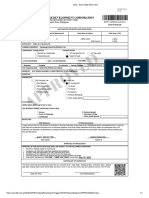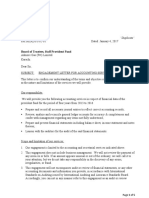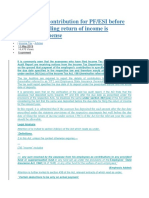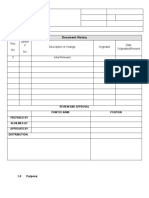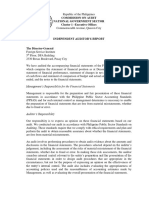Ashish Sharma /Sem.2/ Accountancy 1
Trial Balance
A trial balance is a list of all the general ledger accounts (both revenue and capital) contained in the ledger of a business. This list will contain the name of each nominal ledger account and the value of that nominal ledger balance. Each nominal ledger account will hold either a debit balance or a credit balance. The debit balance values will be listed in the debit column of the trial balance and the credit value balance will be listed in the credit column. The purpose of a trial balance is to prove that the value of all the debit value balances equals the total of all the credit value balances. If the total of the debit column does not equal the total value of the credit column then this would show that there is an error in the nominal ledger accounts.
Objectives of Trial Balance:
1. To check the arithmetical accuracy of books of accounts:
According to the principle of the double-entry system of book-keeping, every business transaction has two aspects, debit and credit. They base on the double-entry principle of debit equals credit or credit equals debt. As a result, the debit and credit columns of they must always be equal. If they do, it assumes that the recordings of financial transactions are accurate.
2. Helpful in preparing final accounts:
They record the balances of all the ledger accounts at one place which helps in the preparation of final accounts, i.e. Trading and Profit and Loss Account and Balance Sheet . But, unless they agree, the final accounts cannot prepare. Final accounts prepare to show profit and loss and the financial position of the business at the end of an accounting period. 3
. To serve as an aid to the management:
By comparing the trial balances of different years changes in figures of certain important items such as purchases, sales, debtors, etc. ascertain and their analysis make for taking managerial decisions. So, it serves as an aid to the management.
4. To Summarize the financial transactions:
A business performs several numbers of financial transactions during a certain period. The transactions themselves cannot portray any picture of the financial affairs of the business. For that purpose, a summary of the transactions has to draw. They prepare to intend to summarize all the financial transactions of the business.


Ashish Sharma /Sem.2/ Accountancy 2
5. To Help to detect accounting errors:
Since the trial balance indicates if there is any error committed in the journal and the ledger; It helps the accountant to locate the error because the starting point of locating errors is trial balance itself. It has been pointed out in an earlier paragraph that if they not agree, the accountant must locate such errors.
Methods of Trial Balance:
A trial balance can prepare by the following three methods;
1. Total method:
In this method, the debit and credit totals of each account are shown in the two amount columns (one for the debit total and the other for the credit total). Under these methods, the trial balance prepares by taking up the total of debits and credit of all ledger accounts.
In this method, the difference of each amount extracts. If the debit side of an account is bigger in amount than the credit side; Also, the difference is put in the debit column of the Trial Balance and if the credit side is bigger; The difference writes in the credit column of the Trial Balance. Under these methods, only the balances of all the ledger accounts take up to prepare the trial balance.
3. Compound Method:
The compound method is the combination of both the methods, total method, and balance method. Thus, the compound method also knows as a total cum balance method.
Ashish Sharma /Sem.2/ Accountancy 3
Advantages of Trial Balance
:
To help of summarizes all the financial transactions of the business. Also, presents to the businessman a consolidated list of all ledger balances.
It is the shortest method of verifying the arithmetical accuracy of entries made in the ledger.
If the total of the debit side/column is equal to the total of the credit side/column, the trial balance says to agree. Otherwise, it implies that some errors have been committed in the preparation of accounts.
It helps in the preparation of the final accounts i.e., Trading a/c. Profit and loss a/c and Balance Sheet.
To help in locating or detecting errors in accounting balances. As well as, helps the accountant to locate the error; Because, the starting point of locating errors is trial balance itself.
They serve as a summary of all the ledger accounts and provides a complete summary report of each account in the ledger
.
Limitations
A trial balance only checks the sum of debits against the sum of credits. That is why it does not guarantee that there are no errors. The following are the main classes of errors that are not detected by the trial balance.
An
error of original entry
is when both sides of a transaction include the wrong amount. For example, if a purchase invoice for Rs.21 is entered as Rs.12, this will result in an incorrect debit entry (to purchases), and an incorrect credit entry (to the relevant creditor account), both for Rs.9 less, so the total of both columns will be Rs.9 less, and will thus balance.
An
error of omission
is when a transaction is completely omitted from the accounting records. As the debits and credits for the transaction would balance, omitting it would still leave the totals balanced. A variation of this error is omitting one of the ledger account totals from the trial balance (but in this case the trial balance will not balance).
An
error of reversal
is when entries are made to the correct amount, but with debits instead of credits, and vice versa. For example, if a cash sale for Rs.100 is debited to the Sales account, and credited to the Cash account. Such an error will not affect the totals.
Ashish Sharma /Sem.2/ Accountancy 4
An
error of commission
is when the entries are made at the correct amount, and the appropriate side (debit or credit), but one or more entries are made to the wrong account of the correct type. For example, if fuel costs are incorrectly debited to the postage account (both expense accounts). This will not affect the totals. This can also occur due to confusion in revenue and capital expenditure.
An
error of principle
is when the entries are made to the correct amount, and the appropriate side (debit or credit), as with an error of commission, but the wrong type of account is used. For example, if fuel costs (an expense account), are debited to stock (an asset account). This will not affect the totals.
Compensating errors
are multiple unrelated errors that would individually lead to an imbalance, but together cancel each other out.
Example
Prepare a Trial Balance with the following information:
Sr. No
Name of Account
Balance
(₹)
Sr. No
Name of Account
Balance
(₹)
(i) (iii) (v) (vii) Capital Cash Creditors Sales 2,00,000 1,80,000 1,00,000 3,00,000 (ii) (iv) (vi) (viii) Stock Debtors Bank Loan Purchases 70,000 3,00,000 1,50,000 2,00,000 Solution
Trial Balance
S. No.
Account Title
Debit
Balance
(Rs)
Credit
Balance
(Rs)
(i) Capital 2,00,000 (ii) Stock 70,000 (iii) Cash 1,80,000 (iv) Debtors 3,00,000 (v) Creditors 1,00,000 (vi) Bank Loan 1,50,000 (vii) Sales 3,00,000 (viii) Purchases 2,00,000 7,50,000 7,50,000


